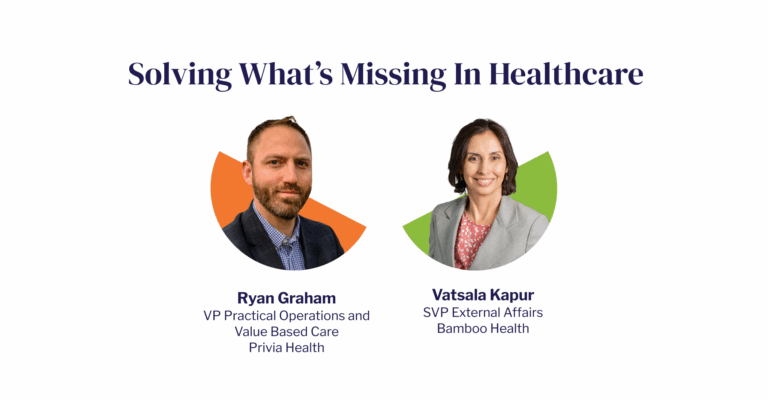A few weeks ago, Chris Skowronek, VP of Corporate Strategy & Partnerships, and Alycia Sepe, VP of Business Development, Payer & State Government Markets were guests on an America’s Health Insurance Plans (AHIP) webinar to highlight changes to 2023 Star Ratings and how Real-Time Care Intelligence™ connects the dots between payers and providers.
The following excerpt is a summary of Chris and Alycia’s presentation. You can watch the full webinar recording here.
The shift to value-based care is having a seismic impact for health plans in terms of how they reimburse for care and support their members. The Centers for Medicare & Medicaid Services (CMS) continue to drive health plans towards value and quality-based arrangements, leaving health plans with the responsibility to shift towards these models.
In addition to the demands of CMS, there are several external industry-wide and economic factors that are driving health plans towards value-based reimbursement models, including:
- The continuous rise of healthcare costs: About $12,530 in healthcare expenses was spent per person in the U.S., reaching a total of $4.1 trillion in 2020.
- The worsening state of behavioral health and substance use: About 32% of American adults with mental illness also experienced a substance use disorder (SUD) in 2020.
- The need for greater collaboration to drive efficiencies: About $1.4 billion in savings from collaborative quality initiatives (CQIs) has been saved through increased payer-provider and provider collaboration.
All these factors result in increasingly complex challenges for health plans, even as many shift focus to the goal of value-based care – high-quality, low-cost care. One tangible area in which we see plans shifting focus to tackle this complexity is quality measures, specifically Medicare Advantage Star Ratings.
CMS has implemented changes in the Medicare Advantage Star Ratings system which have operationally and financially impacted health plans across America. Between 2022 and 2023, the percentage of health plans with a 4 Star rating dropped from 68% to 51%. This decrease subsequently causes significant reduction in revenue and bonus, decreased ability to provide supplemental benefits using rebate on bid, and loss of continuous enrollment.
To combat these unfavorable effects, the CMS made the following changes to Star Ratings for 2023:
- CMS will no longer universally apply the disaster provision as it did in 2022
- CMS will implement annual upper and lower limits, or guardrails, on changes in cut points for non-CAHPS measures beginning in rating year 2023
- CMS will remove performance outliers from the calculation of non-CAHPS measure rating cut points in rating year 2024
- CMS will update measures, including increasing the weight of Plan All Cause Readmissions (PCR) by 3x
With these new provisions, there is an even stronger emphasis on member experience and health equity to deliver whole person care to each member.
Succeeding in quality performance requires alignment between plans and providers – and the tools to enable improvement. Real-time, actionable insights hold the key to delivering whole person care to each member.
Because point solutions are difficult to stitch together, contracting for one solution that guarantees results is preferred by many and can benefit health plans and providers alike. Innovative technology can help to leverage Real-Time Care Intelligence™, extracting data and insights faster to improve payer-provider alignment and improve Star Ratings performance.
Real-Time Care Intelligence can especially help health plans focusing on the Transitions of Care (TRC) and Follow-Up after Emergency Department Visit for People with High-Risk Multiple Chronic Conditions (FMC) Measures.
The four components of the TRC measure include:
- Notification of Inpatient Admission
- Receipt of Discharge Information
- Patient Engagement after Inpatient Discharge
- Medication Reconciliation Post-Discharge
Trigger Event: acute and nonacute discharges on or between January 1 and December 1 of measurement year
The major component of the FMC measure is to calculate the percent of all ED visits for which the member had a follow up service within 7 days of the ED visit.
Trigger Event: all ED visits
To achieve ideal plan-provider collaboration and meet the TRC and FMC measures, here’s an example of an ideal workflow:
- A member’s health plan and primary care provider have a shared understanding of open care gaps.
- Member admitted to hospital, starting the clock on admission notification requirements
- Member’s PCP is alerted in real time that they have been admitted. Notification is documented in the clinical record, and the PCP prepares for discharge planning, including scheduling any follow ups.
- Hospital discharges member – starting the clock on discharge summary and follow up requirements.
- Member’s PCP is alerted of the member’s discharge in real time – discharge summary is delivered within two days and provider documents receipt of notification and discharge summary in their EHR.
- Provider follows workflow & next-step actions to schedule a follow up visit, complete Medication Reconciliation, and document within 30 days.
These quality measures that evaluate transitions of care and post-discharge follow up will present a big opportunity for health plans for 2023.
Payers and providers should investigate technology partners that not only surface care gaps in real time but engage providers and their staff. Investment in real-time reporting and analytics can be used not only be used for enhanced payer-provider collaboration, but also to better enable member experience via coordinated care.
Is your organization looking to leverage real-time insights to improve Transitions of Care quality measures? Contact Bamboo Health today to learn more.



